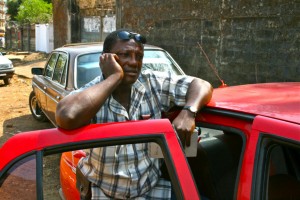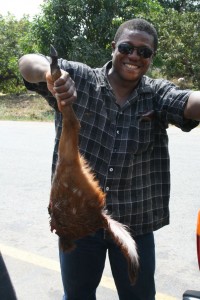Two years ago I returned to Sierra Leone (Return to Freetown, Salone 2010). I made it through the chaos of Lungi Airport at night, stumbled onto a helicopter, and landed on the other side of the estuary. Waiting for me was the welcoming face of Kenawa Bernard, the brother of my good friend Betty Tenga.
Kenawa had taken a couple of weeks leave from his job at the State House to guide me across Sierra Leone. As he put it: “Betty told me to tell you anything you want to know and not to let anything happen to you.” Well, he succeeded on both counts.
I was researching my novel, Three Stone Fire. My goals were ambitious: I wanted to create a route across the country that my female character, Mariama Lahai, would have taken as a captive of the rebel army, the Revolutionary United Front (RUF). I also wanted to learn about Sierra Leonean culture, specifically, about the secret men’s and women’s societies—the Poro and Sandei/Bundu societies.
It was an epic road-trip—we traveled deep into the areas that had been held by ruthless rebel groups for much of the ten year civil war. We drank Star beers and poyo (local palm wine), we ate in markets, got on each others nerves, laughed, spoke of women, politics, religion and everything in between. In short, we became friends and my novel came alive.
 Kenawa guided me to Jose Tenga’s home village of Sumbuya, a place that has become close to my heart. Sumbuya is the village I used as a model for the fictitious Liliema (Peaceful Place) which is where my character, John Rourke finds Mariama Lahai.
Kenawa guided me to Jose Tenga’s home village of Sumbuya, a place that has become close to my heart. Sumbuya is the village I used as a model for the fictitious Liliema (Peaceful Place) which is where my character, John Rourke finds Mariama Lahai.
A year later, I returned to Sierra Leone April of 2011. My intent was to visit Sumbuya, fine tune my narrative, and do a bit of aid work in the village. Prior to arriving I became worried: Kenawa didn’t return emails or phone calls. It wasn’t like him. I travelled independently, but my journey wasn’t the same without Kenawa.
On my return through Freetown I finally got through to my friend: Kenawa was very sick. “An ulcer,” he thought. He was bleeding and in severe pain. When I saw him, I was shocked—my friend had lost over a hundred pounds and was very weak. A religious man, Kenawa prayed constantly and remained optimistic. He received no treatment to speak of and it was all his family could do to help him with some measure of comfort.
Six months later, as the year was drawing to a close, Kenawa succumbed to cancer.
How much do I owe my friend? For a start, my novel would not have been possible without him. He gave me endless material—here is an excerpt of a scene involving Rourke and his driver Mohamed. The character ‘Mohamed’ is a composite of a number of Sierra Leonean men I’ve met, but the following is all Kenawa:
“You like music Mr. John,” he asks, “Dolly Parton? Shania?” Mohamed reaches into the glove box, and pulls out a cassette. He steadies the wheel with his stump, shoves the battered piece of plastic into the player, and turns up the volume.
We listen to Dolly’s Coat of Many Colors, Shania’s You’re Still the One, and a nameless church choir crooning Jesus Touch Me One More Time. The tired cassette repeats itself and Mohamed sings along. Only three songs on the tape and my driver is content to rewind and repeat, rewind and repeat. He apologizes that he doesn’t have any Celine Dion. No worries, I assure him. By the time we’ve made it halfway through Freetown, Jesus has touched us several times.” end of scene
Kenawa did so much more than tell me what I needed to know, and keep me out of trouble. To me, Kenawa Bernard embodied much of what I love about Sierra Leone. He had a sparkle in his eye that was infectious, and his sparkle is sorely missed.